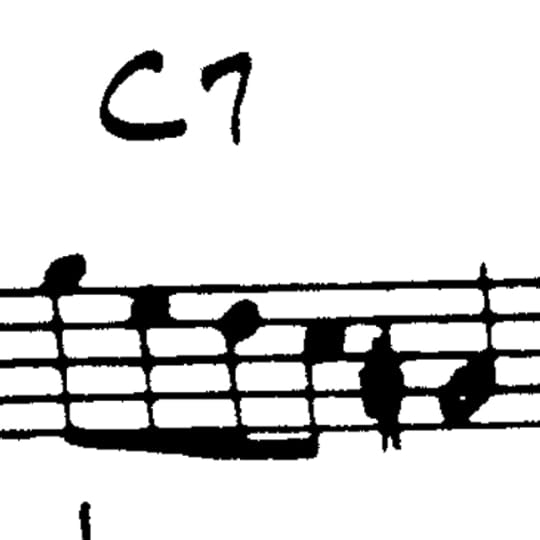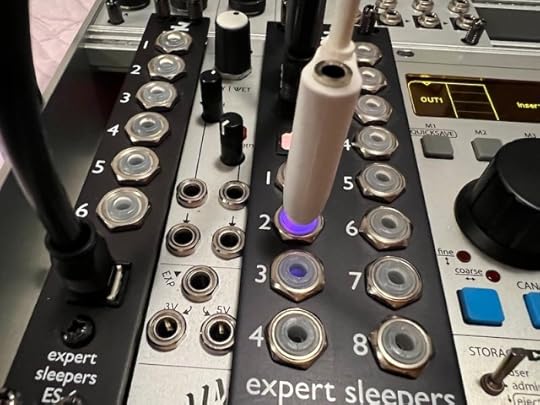Marc Weidenbaum's Blog, page 51
August 12, 2024
Network Packet

Tired: book mobile.
Wired: Internet Archive van.
(Actually, book mobiles still rock.)
August 11, 2024
Sharp Natural Dead Bug

When the Real Book has been photocopied and scanned so many times that you can’t tell a sharp from a natural from a dead bug
August 10, 2024
Scratch Pad: Monolake, Algernon, Soundscape
I do this manually at the end of each week: collating most of the recent little comments I’ve made on social media, which I think of as my public scratch pad. I also find knowing I will revisit my posts to be a positive and mellowing influence on my social media activity. I mostly hang out on Mastodon (at post.lurk.org/@disquiet), and I’m also trying out a few others. And I generally take weekends off social media.
Writing-wise, I had a quite productive week, which may be reflected in my simultaneously limited amount of social media posting:
▰ It’s a Monolake Cinemascope sorta morning, but then again when isn’t it?
▰ There are good guitar class days, and what I have come to think of as Flowers for Algernon guitar class days
▰ Just re-upping my recent article, for JSTOR Daily, about the origins of the contemporary use of the word “soundscape,” including an exercise in listening attentively.
August 9, 2024
Hex Picker

Piecing together a hexaphonic plan thanks to York Modular and Expert Sleepers
August 8, 2024
Disquiet Junto Project 0658: Re-Amplify

Each Thursday in the Disquiet Junto music community, a new compositional challenge is set before the group’s members, who then have five days to record and upload a track in response to the project instructions.
Membership in the Junto is open: just join and participate. (A SoundCloud account is helpful but not required.) There’s no pressure to do every project. The Junto is weekly so that you know it’s there, every Thursday through Monday, when your time and interest align.
Tracks are added to the SoundCloud playlist for the duration of the project. Additional (non-SoundCloud) tracks also generally appear in the lllllll.co discussion thread.
Disquiet Junto Project 0658: Re-Amplify
The Assignment: Re-record and re-compose an organ improvisation by Daniel Glaus.
This project is the last of three that are being done over the course of as many months in collaboration with the 2024 Musikfestival Bern, which will be held in Switzerland from September 4 through 8 (details at musikfestivalbern.ch). We are working at the invitation of Tobias Reber, an early Junto participant, who manages the festival’s educational activities. This year is the sixth in a row that the Junto has collaborated with Musikfestival Bern.
Step 1: Listen to “Kokytos” by Daniel Glaus, available for download here:
“Kokytos” is part of a series of organ improvisations that were recorded with a wide range of microphones placed both inside and around the instrument. This assignment will build on Glaus’ work and take it a step further.
Step 2: Re-amplify the recording, or elements of it, by playing “Kokytos” back over a loudspeaker in locations with unique sonic qualities, and re-recording it. Experiment with unusual placement of speakers and microphones, and with the distance between them. Record as many takes as you like to create a pool of derived samples.
Step 3: Use the pool of sounds resulting from Step 2, compose a piece of your own, perhaps adding further sonic treatment.
Tasks Upon Completion:
Label: Include “disquiet0658” (no spaces/quotes) in the name of your track.
Upload: Post your track to a public account (SoundCloud preferred but by no means required). It’s best to focus on one track, but if you post more than one, clarify which is the “main” rendition.
Share: Post your track and a description/explanation at https://llllllll.co/t/disquiet-junto-project-0658-re-amplify/
Discuss: Listen to and comment on the other tracks.
Additional Details:
Length: The length is up to you.
Deadline: Monday, August 12, 2024, 11:59pm (that is: just before midnight) wherever you are.
About: https://disquiet.com/junto/
Newsletter: https://juntoletter.disquiet.com/
License: It’s preferred (but not required) to set your track as downloadable and allowing for attributed remixing (i.e., an attribution Creative Commons license).
Please Include When Posting Your Track:
More on the 658th weekly Disquiet Junto project, Re-Amplify — The Assignment: Re-record and re-compose an organ improvisation by Daniel Glaus — at https://disquiet.com/0658/
August 7, 2024
808

Tomorrow is my probably second favorite electronic music holiday of the year. (Image by Bryan Pocius, courtesy of a CC BY 2.0 license.)
August 6, 2024
Totally Tubular

I may have purchased some more synthesizer cables
August 5, 2024
My Review of Chrystabell/Lynch’s New LP
I’m very excited to have my latest review up on Pitchfork. It’s of the beautiful new album, Cellophane Memories, by Texas-based singer Chrystabell and famed director David Lynch. This is somehow the second Lynch article I’ve had published this month, the first being an appreciation of his sound design for his great 1999 film The Straight Story; it appeared in The Wire. (Sadly, this week Lynch announced that, a lifelong smoker, he has developed emphysema — an even more serious diagnosis than the one the hero of The Straight Story receives early in that film.)
Here’s the opening section of my Cellophane Memories review:
The presence of director David Lynch’s name atop the new Chrystabell album, Cellophane Memories, will attract curious ears it might not have otherwise. After a few listens, however, you may wonder less about what Lynch brought to the table, and more about why Chrystabell, a Texas-based singer, is credited just once. Cellophane Memories should be attributed not to Chrystabell but to Chrystabells, plural. The greatest virtue of this beautiful album is how it layers her voice over and over—and over—again.
The opening of“With Small Animals” is a prime example of this collage effect—her vocal lines spin free from their ambiguous origin point like threads of an ever-fraying fabric. On “The Sky Falls,” the effect is more strategic, vaguely resembling a classical canon; the pacing of overlaps is ambiguous but still calculable. A synthesizer backdrop lends it an almost irritating texture, giving this seeming evanescence a uniquely off-kilter quality.
Cellophane Memories may be pretty, but it’s not easy. On “Reflections in a Blade,” the vocal bits are harshly clipped, providing a fractured view of an uncertain whole. They flicker by, the patterning delicious, forming a jumbled mess of voices.
The primary aspect of the new album that I focus on in the review is the use of layered vocals. Few singers today have Chrystabell’s smokey glass harmonica of a voice, and fewer still have freed themselves from the rote demands of rhyming as she has, a looseness that serves the album’s alternately diaphanous and fractured sensibility. The duo’s experimental approach to choral singing necessitates some opposing metaphor to the Ship of Theseus myth. In the Theseus story, every part of a ship is replaced over time, leaving one to wonder if it remains the same ship. With Cellophane Memories, the koan is: if a song’s vocal splinters into myriad composite parts, is there even still a song? Either way, a collection of such songs makes an album, and Cellophane Memories is a highly recommended one.
Read my full review at pitchfork.com.
August 4, 2024
Space Camp

Trying to get synthesizer modules to fit can be its own sorta puzzle
August 3, 2024
Scratch Pad: RDJ, VOiP, Books
I do this manually at the end of each week: collating most of the recent little comments I’ve made on social media, which I think of as my public scratch pad. I also find knowing I will revisit my posts to be a positive and mellowing influence on my social media activity. I mostly hang out on Mastodon (at post.lurk.org/@disquiet), and I’m also trying out a few others. And I generally take weekends off social media.
▰ The “RDJ RDJ” chanting at Comic-Con made it clear Michael Giacchino should bring in Aphex Twin for Doctor Doom’s theme
▰ That was quite crazy. I called a string instrument shop, and the sound on the call was bizarre, like a Cylon on Quaaludes. The best I can figure is that VoIP was mistaking the voice of the person who answered and the string in the background as one single sound and was blending them digitally.
▰ The internet changes quickly, but for this brief moment in time, articles I wrote are the leads at both JSTOR Daily (about R. Murray Schafer and the origins of the modern sense of the word “soundscape”) and at 48 Hills (about the novelist Robin Sloan and his new book, Moonbound). I was hopeful for a trifecta, but the third piece due out, at a different website, will likely go live next week.
▰ Overheard at the bookstore:
“How are you?”
“Happy. Because I’m looking at books.”
▰ Street music:

▰ Word for the anticipatory sensation regarding what the Algorithm will serve up the next day after you listen, over the course of a pre-dinner walk, to 10 different versions of the jazz standard* you’ve been practicing for guitar class (and failing to fully absorb its melody)?
*“Easy Living”



